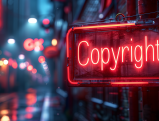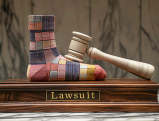
Copyrighting your website is essential to protect your intellectual property rights and to help prevent others from stealing your website content.
by Jonathan Schmig
December 20, 2015
Most people—layman and businessman alike—know the vague contours of what “copyright” means in the U.S.
It’s something that protects original works, like books and music, and it’s often accompanied by the little “©” symbol.
Copyright protection also extends to websites, however, and in a lot of ways, the copyright owner needs to stay on top of those rights in the website more than the writer of a book or the composer of music might.
Understanding why first requires some background.
What is “Copyright” Exactly?
Copyright is one of the three major veins of intellectual property—alongside trademark and patent. They each protect different things.
Trademarks typically protect brand name, slogans and logos. Patents protect designs or processes. Copyrights protect what is called the “authorship”—the articles, the drawings, etc.
Copyright vests immediately upon creation. Or rather, upon “fixation in a tangible medium,” which is legalese for, basically, “made observable to humans.”
You don’t need to register with anyone or sign some formal document in order to have a copyright in your book, song, or website.
That said, registration is wise. It confers a variety of very important benefits.
For one, if you ever want to sue for copyright infringement, you need a registered copyright. That’s crucial for businesses who might need to police copycats.
Another benefit to registration is that it makes it a lot easier to prove infringement, and to establish priority. You also get higher damages and awards for successful suits.
So, no, you don’t need to register your copyright in order to have rights in the work—or even to affix the © symbol to the work—but the system is clearly built in a way to incentivize registration.
This is made all the clearer by how easy (and cheap) it is to actually do so. The basic steps include completing a form (online or paper), sending it in with the standard fee, and then… that’s it.
The fee is typically around $35-$55 (depending on a number of factors, such as whether online or paper (online is cheaper!), whether multiple works, whether multiple authors, etc.).
Compare this with the cost of trademark registration, which can be in the multiple-hundreds, or of patent prosecution, which can cost thousands.
Copyright for a Website
Apart from the more general reasons to care about “copyright” or to care about whether to register, there are several more nuanced issues speaking to websites specifically.
Who Owns the Copyright?
One critical issue is who actually owns the copyright? If you own a business, and you want a website, and you hire a graphic artist to build you that website… then are you the copyright owner of the website? Is the artist? Is the business?
Generally speaking, the simple answer is that the creator is the owner (so in this hypothetical, without any more, the artist you hired would own your website’s copyright). But the two major exceptions to that are employee works-made-for-hire, and contractor works-made-for-hire.
The former is easy: if someone under your employ, full-time, designs the website, the copyright is owned by that person’s employer—you—assuming that the work they did was “within the scope” of their general duties.
The latter situation, however, is trickier and treating the work created by an independent contractor as a work-made-for hire can be problematic under certain circumstances. Specifically, in some states, treating work created by an independent contractor as a work-for-hire can cause result in penalties and fines if the independent contractor gets reclassified as a statutory employee. Accordingly, an assignment clause may be a more viable alternative. Ultimately, consult with an experienced contract attorney to determine what should be included in the contract.
Length of Copyright
Lastly, it’s important to remember that the registration will only be valid so long as that one iteration exists—that is, if you make major revisions, you’d need to re-register (and update the publication year in your copyright notice, which I’ll discuss more in a second). Of course, websites are frequently updated or revised. Minor updates don’t require such registration efforts. Just keep this in mind when you’re editing the content. For general procedures on registering online content, check out Circular 66.
Copyright Protection
Okay, so you own the copyright, and you’ve registered (or you haven’t)—what next? How do you let people know your website is copyrighted? How do you deter infringement?
Sometimes it can be difficult since websites are accessible worldwide. Anyone can access your website, which means anyone can copy or infringe if they so desire.
Worse, there is no global, unified copyright system in place, and while there are a host of international treaties that purport to unite the various regimes into a single, cohesive structure, there are obviously a lot of gaps—one such gap being disparity in enforcement.
Although total protection against all possible infringement, is impossible, there are still some straightforward steps you can do to help nip the problem in the bud as much as possible. These steps begin with affixing the © symbol.
Now, the U.S. has done away with many of the formal requirements, and one of those changes is that the © symbol is no longer necessary—that is, notice to the public is no longer necessary. Again, though, just because it’s not “necessary” doesn’t mean it’s not highly advisable. Providing notice helps tremendously if any sort of issue were to arise.
A sufficient copyright notice in the U.S. will contain three parts: the symbol (either “©,” “Copyright,” or “Copr.”); the publication year (typically the year the website goes live to the public, or underwent its last major update); and the copyright owner’s name. Simple. No specific order is necessary, but those elements are all crucial.
Open almost any website, scroll to the bottom, and you’ll see something like that. Some people use multiple symbols—e.g., “Copyright ©.” Some people add “All rights reserved.” Although just putting the notice on the main page of your website is probably sufficient, many will simply make it a footer and affix it to every page.
Also helpful is creating a hyperlink that directs the viewer to a special page you’ve made outlining the copyright terms in more detail. The point is, there’s plenty of variance, but as long as you put the public on notice of the copyright ownership, your future headaches will be eased, and they will be alleviated further the more detail and care you put into your notice.
Another important tool you can use in your website copyright protection arsenal is the Digital Millennium Copyright Act. This copyright law, which went into effect in 1998, can be used to get website owners, hosting companies and search engines to quickly remove original content which has been copied from your website.
Always stay vigilant and do whatever is in your power to protect the website you have worked so hard to create.
ALSO SEE: 4 Steps to a DMCA Takedown
Topics: Copyright










